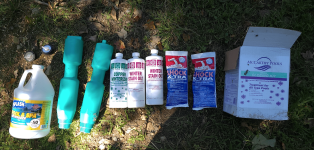- Jun 16, 2022
- 9
- Pool Size
- 21000
- Surface
- Vinyl
- Chlorine
- Salt Water Generator
- SWG Type
- Pentair iChlor 30
Hello!
We had a pool installed last year (installation time lapse), and I’m going to close it myself this year. I looked through other posts, but it seems like my pool is slightly different than what’s covered by the boiler plate closing posts.
Specifically, our installer told us that when we close, a) we don’t need to drain the pool past the skimmers because they installed skimmer guards that somehow allows the pool to drain if it gets past to a certain point (not really sure how this works) and b) we don’t need to clear the lines because they used expandable piping that won’t crack (you can see it in the install video).
With that being said, I linked the video of them closing our pool last year, and a picture of the closing supplies they supplied (I still have the stoppers and skimmer floatation devices). At this point, I’m pretty confident I know what to do, but I (and rightfully – my wife) think we should go off more than this video, and therefore are reaching out to you experts.
Here’s what I’ve observed (and the order in which I would complete it).
Anyways, reassurance or words of wisdom are much appreciated.
Thanks!
We had a pool installed last year (installation time lapse), and I’m going to close it myself this year. I looked through other posts, but it seems like my pool is slightly different than what’s covered by the boiler plate closing posts.
Specifically, our installer told us that when we close, a) we don’t need to drain the pool past the skimmers because they installed skimmer guards that somehow allows the pool to drain if it gets past to a certain point (not really sure how this works) and b) we don’t need to clear the lines because they used expandable piping that won’t crack (you can see it in the install video).
With that being said, I linked the video of them closing our pool last year, and a picture of the closing supplies they supplied (I still have the stoppers and skimmer floatation devices). At this point, I’m pretty confident I know what to do, but I (and rightfully – my wife) think we should go off more than this video, and therefore are reaching out to you experts.
Here’s what I’ve observed (and the order in which I would complete it).
- Do not drain any water
- Shut-off pump
- Drain filter housing
- Disassemble filter housing
- Remove filters
- Dump antifreeze into pump
- Reassemble filter housing (without filters)
- Do nothing with skimmer or drain valves (I.e., remain open)
- Install return stoppers
- Remove skimmer baskets and install skimmer guards
- Dump shock, two bottles of winter stain out, and copper winterizer into the deep end (off camera)
- Turn off main power to pump
Anyways, reassurance or words of wisdom are much appreciated.
Thanks!


